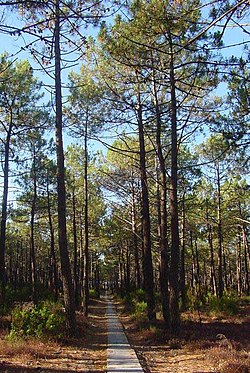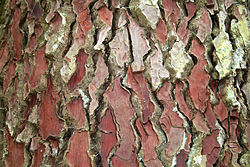Pinus pinaster
species of plant From Wikipedia, the free encyclopedia
Remove ads
Pinus pinaster, also known as the maritime pine, cluster pine, or pinaster pine,[2] is a pine native to the Mediterranean region.
Remove ads
Names
Common names in some other languages are:[2] [1]
- French: Pin maritime, Pin des landes, Pinastre
- German: Strandkiefer
- Portuguese: Pinheiro-bravo
- Spanish: Pino gallego, Pino resinero
Description
The maritime pine is a large tree tree, that grows up to 20–40 m (66–131 ft) tall with an average trunk diameter of up to 35–40 cm (14–16 in).[3] The bark is orange-red and thick, but thinner in the upper parts of the tree.
The leaves ('needles') are in pairs, broad and 10 to 35 cm (3.9 to 13.8 in) long, and bluish-green to yellowish-green.
The maritime pine is monoecious with separate male an female flowers but on the same plant, in cones. The seeds are 8–10 mm (0.31–0.39 in) long, with a 20–25 mm (0.79–0.98 in) wing. Seeds are spread by the wind.
Remove ads
Taxonomy
Pinus pinaster was described by William Aiton, a Botanist from Scotland, in 1789.[4]
There are three subspecies of Pinus pinaster Aiton:[1] [5]
- P. pinaster subsp. pinaster, the typical subspecies, is found in France, Spain and Portugal.
- Pinus pinaster subsp. escarena (Risso) K. Richt found on the western Mediterranean coast, mainly in Spain.
- P. pinaster subsp. renoui (Villar) Maire is found on the African Mediterranean coast, mainly in Morocco, in the Atlas Mountains.
Where it grows
The maritime pine is native to the southwest and southern Europe, North Africa in Morocco, and along the border between Algeria and Tunisia. It is mainly a pine of low, coastal plains, usually on sandy soils of sea shore dunes; however, in Morocco this species can grow in mountains to an elevation of near 2,000 m (6,600 ft).[1]
It has been introduced into regions with a similar Mediterranean climate.
The species is regarded as a highly invasive species. A large production of seeds that are spread by the wind and rapid growth rate all contribute to its ability to invade native habitats, which suffer a loss of species diversity. The maritime pine is reported to be an aggressive colonizer in Chile, Uruguay, Australia, New Zealand and South Africa[3]
Remove ads
Uses
The maritime pine is widely planted for timber in its native area. It is one of the most important trees in forestry in France, Spain and Portugal. The pine forest in Landes in southwest France is the largest man-made maritime pine forest in Europe. The resin is also a source of turpentine and rosin.
As well as industrial uses, maritime pine is also a popular ornamental tree, planted in parks and gardens in areas with warm temperate climates.
It is also used as a source of flavonoids, catechins, proanthocyanidins, and phenolic acids.
Remove ads
Gallery
- Maritine pine trees
- Branches and leaves
- Bark
- Male cone
- Female cone
- Young cone and leaves
- Open mature cone without seeds
- Seeds showing their wings
References
Wikiwand - on
Seamless Wikipedia browsing. On steroids.
Remove ads











